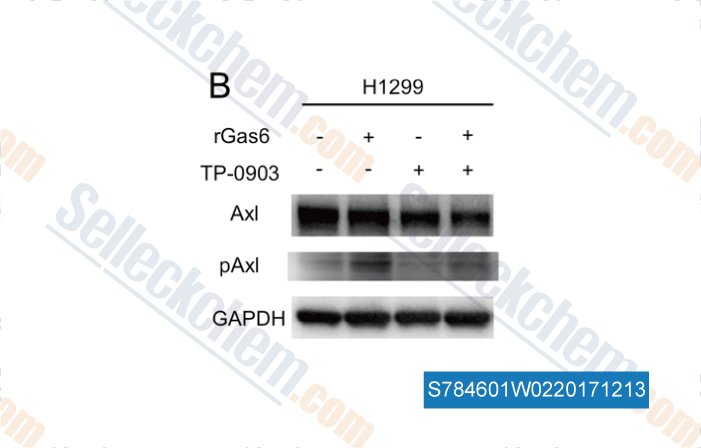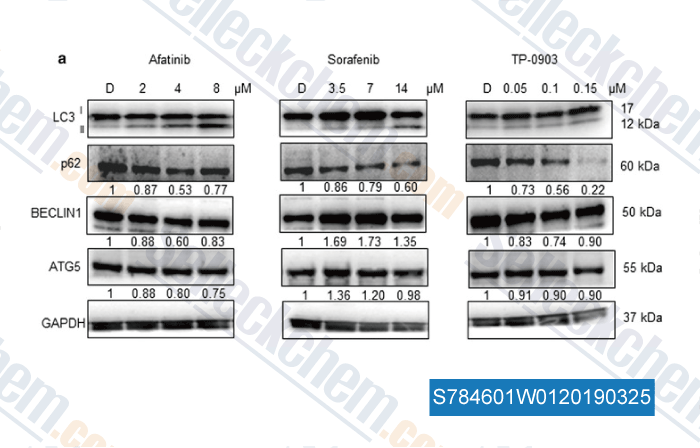|
Toll Free: (877) 796-6397 -- USA and Canada only -- |
Fax: +1-832-582-8590 Orders: +1-832-582-8158 |
Tech Support: +1-832-582-8158 Ext:3 Please provide your Order Number in the email. |
Technical Data
| Formula | C24H30ClN7O2S |
|||
| Molecular Weight | 516.06 | CAS No. | 1341200-45-0 | |
| Solubility (25°C)* | In vitro | DMSO | 3 mg/mL (5.81 mM) | |
| Ethanol | 1 mg/mL (1.93 mM) | |||
| Water | Insoluble | |||
|
* <1 mg/ml means slightly soluble or insoluble. * Please note that Selleck tests the solubility of all compounds in-house, and the actual solubility may differ slightly from published values. This is normal and is due to slight batch-to-batch variations. * Room temperature shipping (Stability testing shows this product can be shipped without any cooling measures.) |
||||
Preparing Stock Solutions
Biological Activity
| Description | TP-0903 is a potent and selective AXL Inhibitor with IC50 of 27 nM. TP-0903 is highly effective in inducing apoptosis. | ||
|---|---|---|---|
| Targets |
|
||
| In vitro | In pancreatic cancer cells (PSN-1), TP-0903 shows strong antiproliferative activity with IC50 of 6 M. TP-0903 also induces strong G2/M arrest by potently inhibiting Aurora A and B. [1] In CLL B cells from all the patients with CLL, TP-0903 causes a dose-dependent induction of massive apoptosis by targeting phosphorylated Axl, and overcomes CLL BMSC-mediated protection of CLL B cells from apoptosis. [2] | ||
| In vivo | In the adult rat hippocampus, the intracerebroventricular administration of SAG (2.5 nM) significantly increases the number of newly generated cells and extends survival of hippocampal cells. [3] In mice, SAG (20 μg/g, i.p.) effectively prevents GC-induced neonatal cerebellar developmental abnormalities. [4] |
Protocol (from reference)
| Kinase Assay: |
|
|---|---|
| Cell Assay: |
|
References
|
Customer Product Validation

-
Data from [Data independently produced by , , Sci Rep, 2017, 7(1):10613]

-
Data from [Data independently produced by , , Cancer Cell Int, 2018, 18:63]

-
Data from [Data independently produced by , , Eur J Pharmacol, 2018, 818:435-448]
Selleck's Dubermatinib(TP-0903) has been cited by 17 publications
| AXL-initiated paracrine activation of pSTAT3 enhances mesenchymal and vasculogenic supportive features of tumor-associated macrophages [ Cell Rep, 2023, 42(9):113067] | PubMed: 37659081 |
| Targeting HER2-AXL heterodimerization to overcome resistance to HER2 blockade in breast cancer [ Sci Adv, 2022, 8(20):eabk2746] | PubMed: 35594351 |
| DETERMINING THE MECHANISMS BEHIND ADAPTIVE RESISTANCE IN FLT3/ITD AML [ Johns Hopkins University, 2022, ] | PubMed: None |
| Three subtypes of lung cancer fibroblasts define distinct therapeutic paradigms [ Cancer Cell, 2021, S1535-6108(21)00492-X] | PubMed: 34624218 |
| Gas6/Axl signaling pathway promotes proliferation, migration and invasion and inhibits apoptosis in A549 cells [ Exp Ther Med, 2021, 22(5):1321] | PubMed: 34630675 |
| Synthetic Lethal and Resistance Interactions With BET Bromodomain Inhibitors in Triple-Negative Breast Cancer [ Mol Cell, 2020, 7;S1097-2765(20)30269-0] | PubMed: 32416067 |
| Lysosomal dysfunction and autophagy blockade contribute to autophagy-related cancer suppressing peptide-induced cytotoxic death of cervical cancer cells through the AMPK/mTOR pathway [ J Exp Clin Cancer Res, 2020, 39(1):197] | PubMed: 32962728 |
| Single-cell Proteomic Profiling Identifies Combined AXL and JAK1 Inhibition as a Novel Therapeutic Strategy for Lung Cancer. [ Cancer Res, 2020, 10.1158/0008-5472.CAN-19-3183] | PubMed: 31992541 |
| Targeting NAD+ biosynthesis overcomes panobinostat and bortezomib-induced malignant glioma resistance. [ Mol Cancer Res, 2020, 10.1158/1541-7786.MCR-19-0669] | PubMed: 32238439 |
| Targeting NAD+ Biosynthesis Overcomes Panobinostat and Bortezomib-Induced Malignant Glioma Resistance [ Mol Cancer Res, 2020, 18(7):1004-1017] | PubMed: 32238439 |
RETURN POLICY
Selleck Chemical’s Unconditional Return Policy ensures a smooth online shopping experience for our customers. If you are in any way unsatisfied with your purchase, you may return any item(s) within 7 days of receiving it. In the event of product quality issues, either protocol related or product related problems, you may return any item(s) within 365 days from the original purchase date. Please follow the instructions below when returning products.
SHIPPING AND STORAGE
Selleck products are transported at room temperature. If you receive the product at room temperature, please rest assured, the Selleck Quality Inspection Department has conducted experiments to verify that the normal temperature placement of one month will not affect the biological activity of powder products. After collecting, please store the product according to the requirements described in the datasheet. Most Selleck products are stable under the recommended conditions.
NOT FOR HUMAN, VETERINARY DIAGNOSTIC OR THERAPEUTIC USE.
